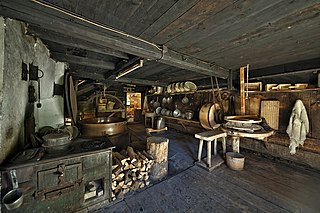
A dairy is a business enterprise established for the harvesting or processing of animal milk – mostly from cows or buffaloes, but also from goats, sheep, horses, or camels – for human consumption. A dairy is typically located on a dedicated dairy farm or in a section of a multi-purpose farm that is concerned with the harvesting of milk.

Holstein Friesians are a breed of dairy cattle originating from the Dutch provinces of North Holland and Friesland, and Schleswig-Holstein in Northern Germany. They are known as the world's highest-production dairy animals.
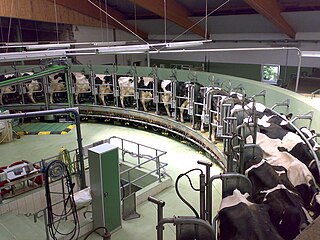
Dairy farming is a class of agriculture for long-term production of milk, which is processed for eventual sale of a dairy product.

Dairy cattle are female cattle bred for the ability to produce large quantities of milk, from which dairy products are made. Dairy cows generally are of the species Bos taurus.

The University of Illinois Experimental Dairy Farm Historic District, also known as South Farm, is a designated historic district in the U.S. state of Illinois. It is located on the campus of the University of Illinois in Urbana, Illinois. The district consists of eight contributing structures and several non-contributing structures. The district was designated in 1994 when it was added to the National Register of Historic Places as part of the Multiple Property Submission concerning Round Barns in Illinois. Three of the district's buildings are early 20th century round barns constructed between 1908 and 1912. The district covers a total area of 6 acres (2 ha).

The Athens State Hospital Cow Barn is a historic agricultural building on the grounds of the former state hospital in Athens, Ohio, United States. One of several agricultural buildings associated with the hospital, it has been named a historic site.
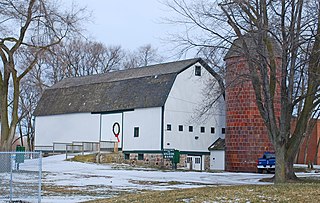
The Wilson Barn is a barn located at the northeast corner of Middlebelt and W. Chicago Roads in Livonia, Michigan. It was listed on the National Register of Historic Places and designated a Michigan State Historic Site in 1973. This was the beginning of the Ira Wilson & Sons Dairy Company, a now defunct company. There were several large iconic cow's head sculptures, which were fixtures in the Detroit metropolitan area.
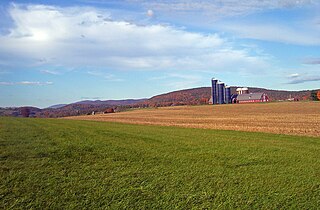
The Coleman Station Historic District is located around the former New York Central Railroad Coleman's station in the Town of North East, New York, United States, a short distance south of the village of Millerton. It is a rural area including several large farms in the southeastern corner of the town. At almost three square miles (7.33 km2), it is the largest historic district entirely within Dutchess County and the second largest in the county.

Signal's Lily Flagg 31035 (1884–?), also spelled Flag, was a Jersey cow, the top butter producer in the world in 1892, owned by W. E. Matthews and General Samuel H. Moore of Huntsville, Alabama. During her record-breaking year, she weighed 950 pounds (430 kg) and produced 1,047 pounds 3⁄4 ounce (474.93 kg) of butter. Her parents were sire Georgian 6073 and dam Little Nan 15895.

The Moody Barn is a round barn in Chisago Lake Township, Chisago County, Minnesota, United States. The farm was first homesteaded in 1871 by Elof and Eva Modig, who emigrated from Sweden. The couple raised five children and grew wheat on their farm, as was common in the 1870s. By the 1890s Minnesota farming had begun to diversify, with cheese and butter production becoming popular and distributed by cooperative creameries. In 1915 Charles Moody, one of the sons, decided to build a modern round barn.

Oren Cornelius Gregg was a farmer and educator from Minnesota. In the 1880s, agricultural education in Minnesota was in trouble: farmers would not travel to the Twin Cities for classes, and university students did not want to study farming. Gregg, a successful dairy farmer from Lyon County, saved the day by bringing lectures directly to farmers. Beginning in 1885, he led the Minnesota Farmers' Institute, a public lecture series that became the agricultural extension service at the University of Minnesota. Through the institutes that he held across the state, Gregg encouraged farmers to diversify their crops and taught them how to make dairy farming more efficient.

Spring Hill Farm is a historic farm at 263 Meriden Road in Lebanon, New Hampshire. Founded in the late 18th century, the farm is noted for innovations in dairy farming practices introduced in the 1920s by Maurice Downs. It is also one of a small number of surviving farm properties in the town, and was listed on the National Register of Historic Places in 2002.
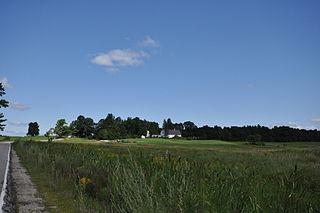
The Jenness Farm is a historic farm property at 626 Pickering Road in Rochester, New Hampshire. It consists of about 190 acres (77 ha) in Rochester and adjacent Dover, and has been in continuous ownership by the Jenness family since 1837. It was, at the time of its 2001 listing on the National Register of Historic Places, one of just ten farms in the city with intact land and buildings.

Briarcliff Farms was a farm established in 1890 by Walter William Law in Briarcliff Manor, a village in Westchester County, New York. One of several enterprises established by Law at the turn of the 20th century, the farm was known for its milk, butter, and cream and also produced other dairy products, American Beauty roses, bottled water, and print media. At its height, the farm was one of the largest dairy operations in the Northeastern United States, operating about 8,000 acres (10 sq mi) with over 1,000 Jersey cattle. In 1907, the farm moved to Pine Plains in New York's Dutchess County, and it was purchased by New York banker Oakleigh Thorne in 1918, who developed it into an Angus cattle farm. After Thorne's death in 1948, the farm changed hands several times; in 1968 it became Stockbriar Farm, a beef feeding operation. Stockbriar sold the farmland to its current owners in 1979.

The Donovan–Hussey Farms Historic District encompasses a pair of 19th-century farm properties in rural Houlton, Maine. Both farms, whose complexes stand roughy opposite each other on Ludlow Road northwest of the town center, were established in the mid-19th century, and substantially modernized in the early 20th century. As examples of the changing agricultural trends of Aroostook County, they were listed on the National Register of Historic Places in 2009.

The John Sweet Donald Farmstead is a historic farm in Springdale, Wisconsin with surviving structures built as early as 1858. It is significant as the home and testing grounds of John Sweet Donald, a farmer, statesman, and educator of the Progressive Era.

The William and Estella Adair Farm, named the Broadacre Farm in 1922, is a 115-acre dairy farm in Carnation, Washington that illustrates the evolution of a typical dairy farming operation in the Snoqualmie Valley. Established in 1910, it was added to the National Register of Historic Places in 2002.

The James and Anne Atmore Bryant Farmstead is a farm located at 12557 L Drive North in Convis Township, Michigan. It was listed on the National Register of Historic Places in 2002.
The dairy industry in the United States includes the farms, cooperatives, and companies that produce milk and cheese and related products, such as milking machines, and distribute them to the consumer. By 1925, the United States had 20 1.5 million dairy cows, each producing an average of 4200 lb of milk per year. By 2007, there were 9.1 million dairy cows but their average milk production was over 20,000 pounds per year, with eight pounds per gallon.

Dairy is a major industry in the state of Wisconsin. The state is widely known for its dairy production, as can be seen with "America's Dairyland" being one of Wisconsin's nicknames.























